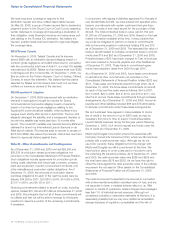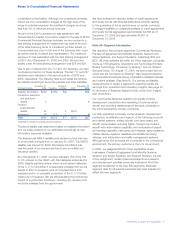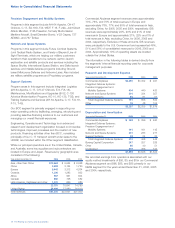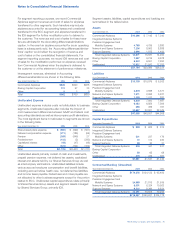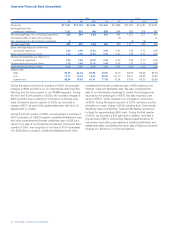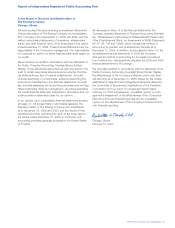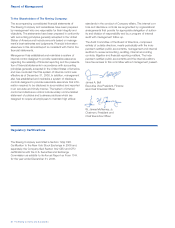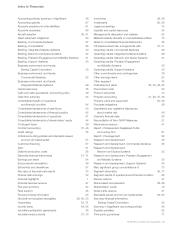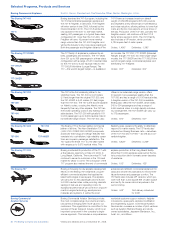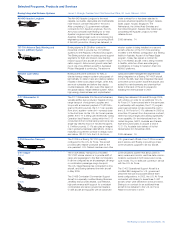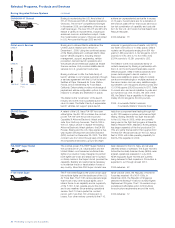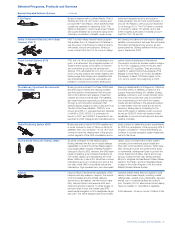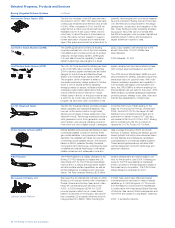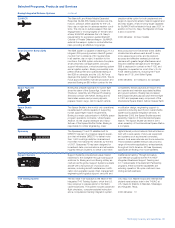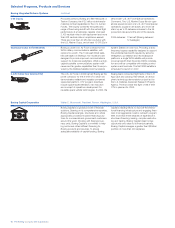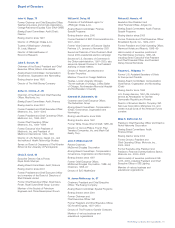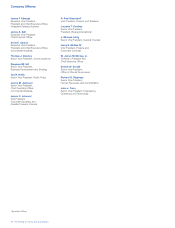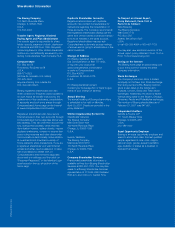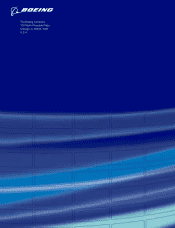Boeing 2006 Annual Report Download - page 88
Download and view the complete annual report
Please find page 88 of the 2006 Boeing annual report below. You can navigate through the pages in the report by either clicking on the pages listed below, or by using the keyword search tool below to find specific information within the annual report.
86 The Boeing Company and Subsidiaries
Selected Programs, Products and Services
Delta Launch Services
Delta II
Delta IV
Boeing and Lockheed Martin established the
United Launch Alliance joint venture on
December 1, 2006. Using the combined assets
of the Boeing Delta and Lockheed Martin Atlas
launch vehicle programs, including mission
management, support, engineering, vehicle
production, test and launch operations and
the people whose intellectual capital will enable
the new venture, ULA provides satellite launch
services to U.S. government customers.
Boeing continues to offer the Delta family of
launch vehicles to commercial customers through
a services agreement with the ULA at its launch
facilities at Cape Canaveral Air Force Station,
Florida, and at Vandenberg Air Force Base,
California. Delta rockets provide a wide range of
payload and vehicle configuration options to deliver
missions to virtually any destination in space.
The Delta II is the “workhorse” of the launch
industry and is the most successful launch vehi-
cle in its class. The Delta II family of expendable
launch vehicles can support space launch
missions to geosynchronous transfer orbit (GTO),
low-Earth orbit (LEO) or to deep space. Delta II
rockets can lift payloads ranging from 891 kilo-
grams (1,965 pounds) to 2,142 kilograms (4,723
pounds) to GTO; and 2.7 to 6.0 metric tons
(5,934 pounds to 13,281 pounds) to LEO.
The Delta IV is the most advanced family of
rockets developed by Boeing in partnership with
the U.S. Air Force Evolved Expendable Launch
Vehicle program. Delta IV blends advanced and
proven technologies to launch medium- to
heavy-size satellites to space. Delta IV rockets
can accommodate single or multiple payloads on
the same mission and can carry satellites weigh-
ing between 4,210 kilograms (9,285 pounds) and
13,130 kilograms (28,950 pounds) to GTO. Delta
IV rockets also can launch satellites to polar and
sun-synchronous orbit. At LEO, the orbit of the
ISS, the Delta IV has a capability to lift approxi-
mately 23,000 kilograms (50,000 pounds).
2006: 5 successful Delta II missions;
3 successful Delta IV missions flown
Medium Medium
Plus Heavy
EA-18G Growler A variant of the U.S. Navy F/A-18F two-crew
strike fighter, the EA-18G combines the combat-
proven F/A-18F with the proven Improved
Capability III Airborne Electronic Attack avionics
suite from Northrop Grumman. The EA-18G is
the U.S. Navy’s choice to replace the existing
Airborne Electronic Attack platform, the EA-6B
Prowler. Boeing and the U.S. Navy signed a five-
year System Development and Demonstration
(SDD) contract on December 29, 2003. The SDD
contract runs from 2004 through early 2009 and
encompasses all laboratory, ground and flight
tests from component-level testing through full-
up EA-18G weapons system performance flight
testing. Boeing delivered two flight test aircraft
to the U.S. Navy in 2006, which are currently
being used in the flight test program at Naval Air
Station Patuxent River, Maryland. Boeing already
has begun assembly of the first production EA-
18G and will fly that aircraft in third quarter 2007.
The first EA-18G aircraft will join the U.S. Navy’s
fleet in 2008, with initial operating capability for
the EA-18G expected in 2009.
F/A-18E/F Super Hornet The combat-proven F/A-18E/F Super Hornet is
the cornerstone of U.S. naval aviation and the
United States’ most advanced multirole strike
fighter in production today. Designed to perform
both fighter (air-to-air) and attack (air-to-surface
or strike) missions, the Super Hornet provides the
capability, flexibility and performance necessary
to modernize the air or naval aviation forces of
any country. More than 296 Super Hornets have
been delivered to the U.S. Navy, and all were
delivered ahead of schedule. The Super Hornet’s
Active Electronically Scanned Array (AESA) radar
entered operational evaluation in July 2006.
AESA-equipped Super Hornets are currently
being delivered to fleet squadrons. Production is
expected to run through at least 2013.
2006 deliveries: 42
F-15E Strike Eagle The F-15E Strike Eagle is the world’s most capa-
ble multirole fighter and the backbone of the U.S.
Air Force fleet. The F-15E carries payloads larger
than those of any other tactical fighter, and it
retains the air-to-air capability and air superiority
of the F-15C. It can operate around the clock
and in any weather. Since entering operational
service, the F-15 has a perfect air combat
record, with more than 100 victories and no
losses. Four other nations currently fly the F-15.
Since October 2005, the Republic of Korea Air
Force has received 18 of 40 F-15Ks. In
December 2005, the Republic of Singapore
selected the Boeing F-15SG for its Next Fighter
Replacement Program. The F-15 remains a sup-
portable and affordable option to fill multirole
force structure requirements around the world.
2006 deliveries: 12
Boeing Integrated Defense Systems continued
CH/MH/HH-47 Chinook Boeing is modernizing the U.S. Army’s fleet of
CH-47 Chinooks and MH-47 Special Operations
Chinooks. The CH-47F completed its first flight
in November 2006, and deliveries of the new air-
craft have begun. The new CH-47F and MH-47G
feature a variety of improvements, including an
advanced common architecture cockpit. Under
the modernization program, Chinooks will remain
in U.S. Army service through 2035 and will
achieve an unprecedented service life in excess
of 75 years. Current plans are for a derivative of
the Chinook called HH-47 that would serve as a
low-risk combination of capability and cost plat-
form for the U.S. Air Force’s Combat Search and
Rescue helicopter.
2006 deliveries: 18


